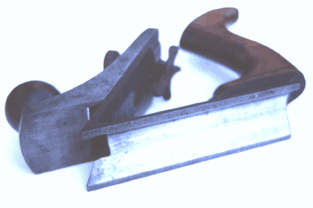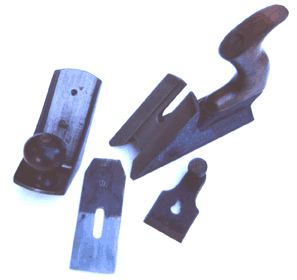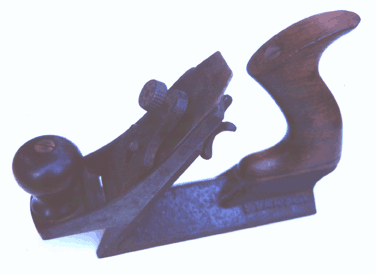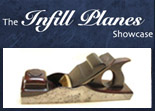Stanley #72 Chamfer Plane
Classic Plane Review
The Stanley Rule & Level Company introduced Its #72 Chamfer Plane in 1885, and continued to manufacture it until 1938. While it was by no means one of Stanley’s “big sellers”, it is reasonable to assume that it must have sold in sufficient numbers to warrant Its inclusion in the product line for some fifty-four years. Certainly Its occurrence amongst collectors and second-hand dealers suggests that although it wasn’t common, it was popular enough to find Its way into thousands of workshops and tool kits. It’s not hard to see why either – it really is a good little plane.
While everything this plane does can be achieved with other bench planes, spoke shaves or draw knives, the #72 just makes things a little quicker and easier. Sure you can plane off the edges of your dining table with an ordinary Stanley #4 or #5, but it might be a little difficult to stop that sucker from rocking to and fro. With the #72 you don’t have to worry – all you have to do is hold it down, and push forward, and before you know it, your table has a nice clean and smooth chamfer along its edge.
The #72 can cut chamfers up to 1 1/4 inch in width, which for most jobs, is quite sufficient. The actual width of the cutter however, is 3/8 inch wider at 1 5/8 inch. The bed angle of the cutter, in untypical Stanley fashion, is 50 degrees, and the cutter itself is positioned in the same manner as the bench planes, with the bevel down. Unfortunately the thin cutter has no backing iron and thus is prone to chatter when working wide chamfers in hard timbers. There is also no provision made for the adjustment of the cutter in either the depth of cut, or the lateral movement. Instead, the depth of cut (or more precisely, the width of the chamfer) is determined by raising or lowering the front portion of the plane itself. This front section rides on a locating groove milled into the back casting, and is secured in position by a large five pronged nut at the rear of the two mating surfaces. Pressure is applied to the cutting iron by a screw adjusted lever cap, rather than the more conventional cam operated lever found in most Stanley type bench planes. It is interesting to note that the later model #72’s came with an additional bullnose attachment to use in place of the existing front piece. This handy extra would have no doubt come at an additional cost to the consumer.

Showing the “Vee” shaped sole.
In the particular plane shown in the accompanying photographs the Stanley name is cast into the face of the screw head. The name also appears on one side of the back casting – just so there can be no mistake as to who made this plane. On the other side of the casting, the number and the patent date is clearly visible. It reads:
No 72.PAT.APR.21-85
This plane originally came to me with a type 6 cutting iron, and even though it still had over an inch left in the blade, I decided to exchange it for a thicker one. The replacement cutter was initially a warranted cast steel tapered one by Mathieson of Glasgow. This was surface ground on both sides to an effective cutting thickness of almost 1/8 of an inch. This is almost double the thickness of the Stanley cutter, which meant that the chattering was considerably reduced when working hard and difficult timbers. The 50 degree “York pitch” also contributed greatly to the planes performance, as did the narrowing of the plane mouth due to the thicker blade. Being originally tapered, I was able to grind the cutter in such a way as to leave the makers mark intact. While this is not important for the overall performance of the plane, I felt it was necessary to give the manufacturer of the iron due recognition.

Chamfer Plane: The sum of the parts ( with thicker Mathieson replacement cutter ).
The plane itself is in good condition, with most of the original Japanning intact, and not even the slightest hint of cracking in either the castings or the woodwork. Both the handle and knob are crisp, comfortable and retain most of their finish. The front knob is the earlier “low type” pattern and, like the handle, is made from reasonably figured Brazilian Rosewood (Dalbergia nigra). The castings are marked with the letter “B” on the front, back and the underside of the lever cap. This is the foundry marking though, to my knowledge the exact foundry in which these castings were made has not yet been identified. There is enough information however, to ascertain that the manufacturing date of this plane would seem to be around 1900, as the “B” marking is typical of a type 8 Stanley.
This plane is every bit a user, especially after some initial “tweaking”, and it literally takes minutes to plane a 1 1/4 inch wide chamfer around a table top. A #72 is a lot quicker and easier to use than it is to set up a router though, and much quieter too! The only drawback is its price – usually between $200 and $400. Still, if you’re into chamfering in a big way and like using handplanes, the Stanley #72 may be just up your alley.

Chamfer Plane with frontpiece raised.
NB: The #72 1/2 was exactly the same plane as #72, except that it came with an additional beading attachment, which included 6 molding cutters (these cutters being the same as was offered in the #66 and #69 hand beaders). The #72 1/2 was offered from 1886 through to 1917 and also included a bullnose attachment in later models. While these attachments make the #72 more versatile, they do have the unfortunate effect of adding more dollars onto the cost of the plane.
Stanley #72 Chamfer Plane
| Features: | Adjustable frontpiece, 50 degree “York” Pitch |
| Manufactured: | 1885 through to 1938 |
| Dimensions: | 9 inches Long x 2 inches Wide x 5 1/4 inches High |
| Cutter: | 1 5/8 inches Wide x 5 1/4 inches Long |
| Construction: | Cast iron body with rosewood handle and knob |
| Finish: | Japanned. varnished rosewood handles |
| Uses: | Cutting chamfers between 1/4 inch to 1 1/4 inches wide |
| Notes: | Bullnose attachment included with later types |
| Typical Price: | $200.00 to $500.00, depending on condition |






